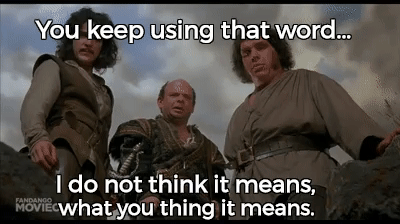We need to talk about "evolution"

Did you know that the line up drawing of increasingly more upright apes is called the "march of progress"? Or that old ideas of evolution were tied up in an idea that it was a shift from "primitive" to "refined" or "advanced"? Hopefully, you're thinking "wow, 'primitive' is a pretty cringey word, I'm sure we've learned better". And we have, in terms of our scientific understanding of evolution in living creatures. We now understand human evolution, for example, with the "braided stream" model, which is a refinement of the "family tree" model, and a major step away from the linear "primitive - to - advanced" ideas that were popular around the time of the Chicago World's Fair.
If you had a good history teacher, you probably remember that around that time some people were twisting popular understanding of science to suit their own agendas. This included twisting the study of languages to imply that Western European languages had been developed later and were therefore, better, while compressing Non-Euro-American cultures into flattened timelines imagined to be older, "primitive", and and unchanging (Khalila Indivar, Dancing at the Fair lecture, on Teachable). This baggage is often found in the subtexts (and sometimes the text-text) when some people talk about the evolution of dance.
Dance most certainly does evolve, but not in the way people seem to mean when they use the argument to defend introducing new elements that distance it from cultural context and meaning. Evolution in creatures happens when random mutations are selected for, or against, by their environment. It does not move towards an ideal (if you need proof of this, just look at the human knee joint) or away from something "primitive", creatures are simply shaped by the environment they are trying to survive in. An organism also cannot pick a direction to evolve in, random mutations occur and they either help an organism's chances of passing on their genes, hurt them, or have no impact.
That means one version is not better or worse, just more suited for passing on its genes.
So, what does this have to do with dance? First, although we can make choices about how to "mutate" our dance, just like real evolution we must build on what came before. And, like real evolution, which changes get passed on depend on the environment.
Instead of the ability to get food and hide from predators selecting traits, it is the audiences who choose whether the dance is still successful, or if something new is needed. And those audiences will decide which changes are worth "passing on" by their applause and by rehiring or referring a dancer, or not.
Unlike actual evolution, many people use "dance evolves" to defend directed attempts to "refine" and "elevate" the dance. In any case, the context is the key. If two populations of animals find themselves separated and in different environments, over enough generations they can become different species. If two schools of the same dance find themselves separated and performing for different audiences, they can become different styles.
In nature, selection criteria might include the animal's ability to move though the environment, or to sneak up on their dinner, or to keep their young away from predators. If nothing in their environment changes, then the species is unlikely to change. However, if the environment becomes flooded, those individuals who happen to be better swimmers will be more likely to survive.
In dance, those "natural selection criteria" are deeply based in cultural values, and often change depending on technology, political, economic, and other social shifts. For example, when the economy takes a downward turn, those dancers who can put on a good show with a smaller band are more likely to survive.
So, when looking at a dance style, you must always consider the context the dancer is making their living in. Is art being patronized by a wealthy elite? Is there a new technology like the cassette player spreading a new sound? Has the county been taken over by the Ottomans recently? Is the audience a mixture of diaspora from all over the SWANA region who just want a taste of home and to be with people who understand their background for an evening? Is the dancer being hired by other dancers to teach them something difficult, or hired by a family celebrating a wedding to help them have fun?
To say "dance evolves" as a defense for removing the dance from its cultural context is not only a major misunderstanding of the integral role of culture in shaping the dances that belong to it, it is also a confession that one does not understand how evolution works.
